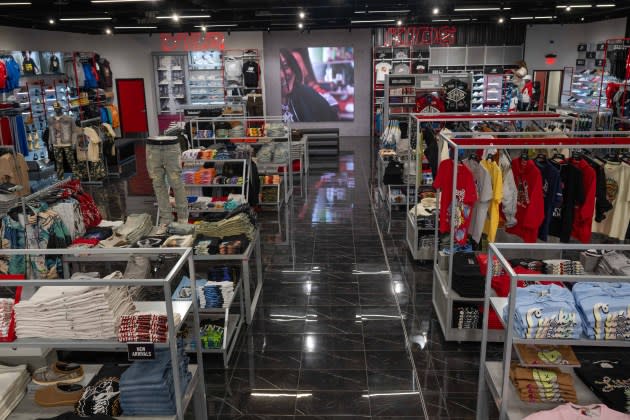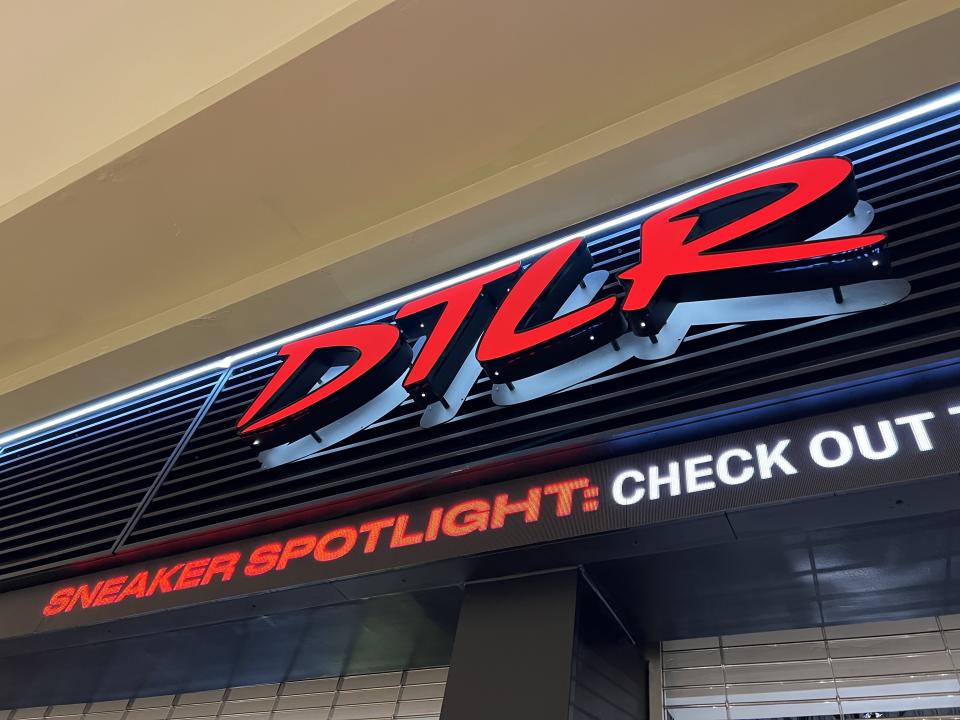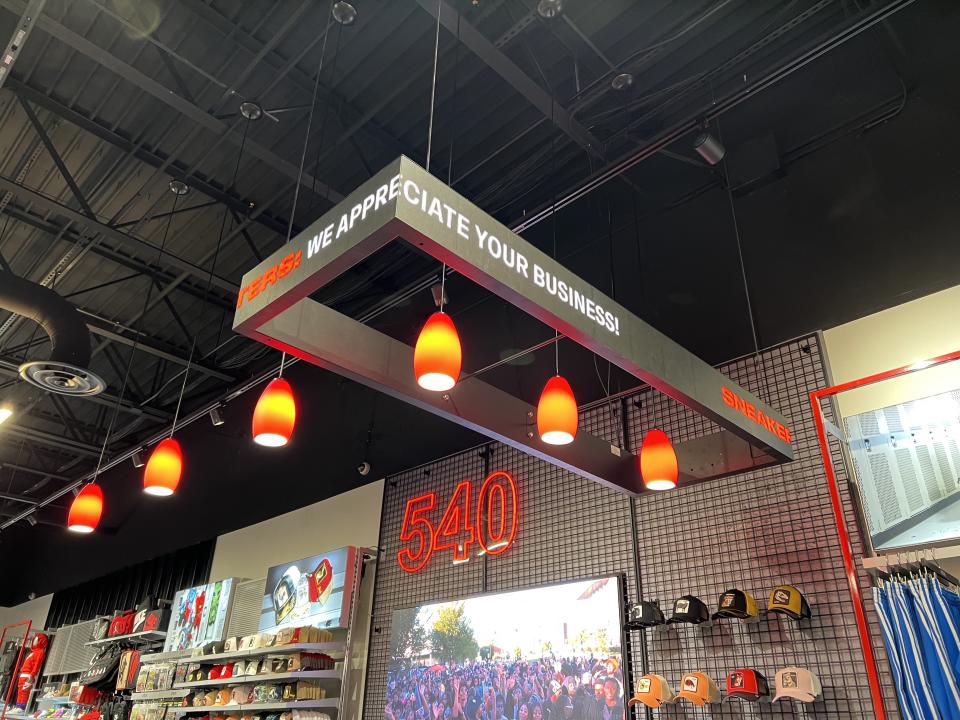DTLR Names Todd Kirssin CEO, Opens Next Generation Flagship

There’s a fresh face at the helm of DTLR — but it’s hardly a new one.
Todd Kirssin has been with the streetwear retailer for more than two decades, working his way up from a footwear buyer to president and chief merchandising officer, and now chief executive officer. He takes over a role held jointly by Scott Collins, who stepped down last year, and Glenn Gaynor, who will be exiting in March.
More from WWD
One of the first moves he’s overseeing as CEO is Wednesday’s opening of a new flagship concept in the Spotsylvania Towne Centre in Fredericksburg, Va.
The 7,000-square-foot store, which the company is calling “Next Gen,” will feature a number of bells and whistles including digital ticker tapes that will keep customers informed about exclusives and new arrivals. There will also be digital TVs that will showcase visuals from the store’s top brands along with community events and tips about the latest trends and products.
The new store design features a polished logo fascia application, an open ceiling, integrated shelf illumination, stand-alone mid-floor brand capsules and other fixtures.
“Elevating the shopping experience involves creating a unique and memorable store concept that goes beyond the traditional retail model,” Kirssin said. “This ‘Next Gen’ concept marks the future of DTLR’s retail presence as we look to engage customers not only with our products, but the lifestyle we project, and the communities we serve.”
The design will be rolled out to all new locations that will be opened in the future.
The opening of the Fredericksburg store comes as DTLR celebrates its 40th anniversary. The company, formerly known as Downtown Locker Room, currently operates more than 240 stores in 19 states. It started out in Towson, Md., in 1983 as Athletic Attic Footwear, targeting the hip-hop/urban community, and opened its first store under the Downtown Locker Room name soon after.
By 1998, it had expanded into apparel and in 2008, rebranded as DTLR. In 2017, it merged with Philadelphia-based Sneaker Villa and added 125 locations to its stable, bringing its store count to 237. This attracted the attention of U.K.-based JD Sports, and in 2021, the parent of Finish Line, Shoe Palace and JD bought the business for $495 million from its private equity owners.
In the past several years JD has been working to expand its reach in the U.S., starting with Finish Line, which it bought for $558 million in 2019, followed by the San Jose, Calif.-based Shoe Palace, which it purchased at the end of 2020 for $325 million. Now it has turned its attention to DTLR.

Kirssin has seen a lot of changes since coming on board as the footwear buyer in 1999 when the company only had 12 stores. While it has grown substantially, its focus has remained the same: inner-city youth. Kirssin, who spent most of his time at the company as the chief merchant, said the stores today are 70 percent footwear and 30 percent apparel and carry brands popular with young shoppers such as Nike, Jordan, Hoka, Adidas, Levi’s, Timberland, Ugg, New Balance, The North Face, Champion, Billionaire Boys Club, Puma, Mitchell & Ness and others.
“Our success really comes from the niche consumer who loves sneakers,” he said. “We pair that with fast-fashion apparel brands, the latest, greatest athletic product and mid-to-higher tier sportswear and streetwear brands for men, women and kids. With that mix, we have something hot all the time and can service anybody walking through our door.”
Another key to its success, he said, is that DTLR works with apparel brands to create special styles and colors to match the hot sneaker releases. “We’re very sneaker focused because our kid dresses from the foot up,” he said. “He knows the shoes he wants a month out, so we try to hook him up with a few different options and outfits — from his headwear to his T-shirt to his socks. That gives us a flavor and uniqueness that Foot Locker or even our cousins at JD or Finish Line don’t have.”
The target customer is between ages 13 and 30 and mostly male. Around 150 of the stores carry womenswear and 100 have kidswear. “We got into those categories later in our history,” he said, and due to space constraints, not every unit can carry every category. But going forward, that will change, he said. “One of my focuses will be on modernizing and upsizing the stores. We’ll be moving to better spots, taking more square footage so eventually all of the stores will have footwear, apparel and accessories for men, women and kids.”

Right now, most of the fleet is around 4,500 square feet but the goal is to find spaces of around 6,000 square feet “to show the apparel better.”
Kirssin said there are no plans to double the size of the chain, but instead, to focus on “growing within our skin.” The bulk of the stores are located in the Mid-Atlantic and the East and there are some locations where the company can add units in existing markets. For the most part these stores will be in communities where its customers live.
“Our superpower is in the streets,” Kirssin said, adding that DTLR operates 190 neighborhood stores, a contrast to Finish Line and JD, who generally opt for malls. Although DTLR does have 60 mall stores, it’s the street where it thrives.
“That’s our unique proposition. Some of our stores are in smaller neighborhoods, so they’re not as high-volume, but they have become a part of the community. These kids come in two or three times a week and we ship product to the stores every day for them because that speed to market is so key,” he said.
Striking when the proverbial iron is hot is essential when targeting a young customer whose tastes can change on a dime.
“We want to be the first one in on a trend and then the first out,” he said. “Markdowns are painful. But it’s like a memo goes out when they don’t want it anymore. It’s like every kid knows to not buy it and you’re stuck with 250 stores selling a bucket hat, or whatever the trend was.”
So how does Kirssin stay one step ahead of his customers to ensure DTLR sells what they want? Oftentimes, it’s gut instinct.
Kirssin said he started working at a local shoe store in his hometown of Baltimore after school and on weekends when he was a teen and this was where he developed a sixth sense around what he calls “the urban ethnic trade. For whatever reason, that just became my superpower in life. I just know what the next trend will be.”
Since becoming part of a larger retail conglomerate, DTLR has also been able to take advantage of the sales data and logistics from all of the JD banners to further hone the company’s merchandising.
Although the target customers of each chain are different, there are a lot of similarities. Shoe Palace, which is on the West Coast , has a large Hispanic following. DTLR is a neighborhood community chain with a focus on Black consumers, while Finish Line is “middle America,” he said. But many of the hot brands overlap — Hoka, On, Crocs and others — offering the stores more leverage. “We meet once a month but we don’t want to be homogenous. But we’re like the retail Voltron, all the parts come together as one big, strong machine. Information is key in this business. The faster you move, the better.”

Right now New Balance is hot — the chain does a special collaboration with the brand every other month — as is Nike and Jordan, BBC, Psycho Bunny, Boss, Sergio Tacchini, Armani Exchange and Kappa, he said. And Goorin Hats and Ethika underwear are also popular with customers. “You can’t get that at Foot Locker,” he said. “But we don’t take sales away from anyone because they don’t have any other distribution within three to 10 miles of our stores.”
In the past, there were dozens of multibrand retailers targeting the young, urban market — remember Merry-Go-Round, Chess King and Structure? — but most have gone to the retail graveyard.
“There are not many retailers like us left,” Kirssin said. “Our competition is anybody who sells cool brands. We try to be at the middle to upper level, we’re never going to be luxury. Before, some of the cool brands didn’t want our business because they weren’t crazy about our market, but now they realize that our customer shops.”
The company will also continue to be a conduit for the community. It has its own streaming radio station, hosts community outreach events at its stores and gives back when it can. Lately, the events have centered around voting, health, education and other issues that impact DTLR’s customers.
As Kirssin settles into his new role as CEO, he will work closely with Tina Wade, senior vice president and general merchandise manager, and a 20-year DTLR veteran, who will take over as chief merchant.
While it may be hard for him to relinquish his buying responsibilities, he’ll have plenty to keep him busy.
“Our aspiration is to get to over 300 stores, and we have the lane to do it,” he said. “There’s a whole big country here and there’s plenty of white space for us.”
Best of WWD

